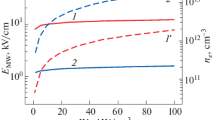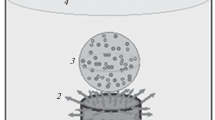Abstract
This work is devoted to simulating a microwave discharge in water and studying kinetic processes in a gaseous mixture of water decomposition products. Calculations have been performed for atmospheric and low pressure and a constant gas temperature. A one-dimensional model has been developed on the basis of the joint solution of the balance equation for neutral and charged plasma components, the Boltzmann equation, the equation for the stationary distribution of the microwave field in the plasma-filled volume, and the Poisson equation. Using the zero-dimensional model, an abridged kinetic reaction scheme for water vapor plasma was obtained, which was employed in the one-dimensional model. The calculations have been carried out for preset values of the microwave field. It has been shown that the modes of transition from electronegative to electropositive plasma obtained using the zero-dimensional model at E/N values above 350 Td are not observed in the case of the one-dimensional model of microwave discharge. In a wide range of microwave field values specified on the antenna, the microwave plasma in water is electronegative. The concentration of electrons is low in comparison with the concentration of positive ions H3O+, \({{{\text{H}}}_{5}}{\text{O}}_{2}^{ + }\), and H3O+(H2O)3, quasi-neutrality is maintained by the negative ion OH−, and the degree of dissociation of water does not exceed 20–25%.










Similar content being viewed by others
REFERENCES
Bruggeman, P.J. and Leys, C., J. Phys. D: Appl. Phys., 2009, vol. 42, p. 053001.
Samukawa, S., Hori, M., Rauf, S., et al., J. Phys. D: Appl. Phys., 2012, vol. 45, p.253001.
Bruggeman, P.J., Kushner, M.J., Locke, B.R., et al., Plasma Sources Sci. Technol., 2016, vol. 25, p. 053002.
Horikoshi, S. and Serpone, N., RSC Adv., 2017, vol. 7, p. 47196.
Adamovich, I., Baalrud, S.D., Bogaerts, A., et al., J. Phys. D: Appl. Phys., 2017, vol. 50, p. 323001.
Lebedev, Yu.A., Plasma Phys. Rep., 2017, vol.43, p. 676.
Vanraes, P.A. and Bogaerts, A., Appl. Phys. Rev., 2018, vol. 5, p. 031103.
Lebedev, Yu.A., High Temp., 2018, vol. 56, p. 811.
Malik, M.A., Ghaffar, A., Malik, S.A., Plasma Sources Sci. Technol., 2001, vol. 10, p. 82.
Rybkin, V.V. and Shutov, D.A., Plasma Phys. Rep., 2017, vol.43, p. 1089.
Foster, J., Phys. Plasmas, 2017, vol. 24, p. 055501.
Rezaei, F., Vanraes, P., Nikiforov, A., et al., Materials, 2019, vol. 12, p. 2751.
Aoki, H., Kitano, K., and Hamaguchi, S., Plasma Sources Sci. Technol., 2008, vol. 17, p. 025006.
Hattori, Y., Mukasa, S., Nomura, S., et al., J. Appl. Phys., 2010, vol. 107, p. 063305.
Hattori, Y., Mukasa, S., Toyota, H., et al., Surf. Coat. Technol., 2012, vol. 206, p. 2140.
Horikoshi, S., Sawada, S., Sato, S., et al., Plasma Chem. Plasma Process., 2019, vol. 39, p. 51.
Ishijima, T., Hotta, H., Sugai, H., et al., Appl. Phys. Lett., 2007, vol. 91, p. 121501.
Ishijima, T., Sugiura, H., Saito, R., et al., Plasma Sources Sci. Technol., 2010, vol. 19, p. 015010.
Maehara, T., Honda, S., Inokuchi, C., et al., Plasma Sources Sci. Technol., 2011, vol. 20, p.034016.
Sato, S., Mori, K., Ariyada, O., et al., Surf. Coat. Technol., 2011, vol. 206, p. 955.
Zhao, X.-T., Zhu, X.-M., Yan, Z.-Y., et al., IEEE Trans Plasma Sci., 2016, vol. 44, no 8.
Nomura, S., Toyota, H., Mukasa, S., et al., Appl. Phys. Express, 2008, vol. 1, p. 046002.
Li, H.O.L., Kang, J., Urashima, K., et al., J. Inst. Electrostat. Jpn., 2013, vol. 37, p. 22.
Hattori, Y., Mukasa, S., Toyota, H., et al., Curr. Appl. Phys., 2013, vol. 13, p. 1050.
Tian, W., Tachibana, K., and Kushner, M.J., J. Phys. D: Appl. Phys., 2014, vol. 47, p. 055202.
Takeuchi, N., Ishii, Y., and Yasuoka, K., Plasma Sources Sci. Technol., 2012, vol. 21, p. 015006.
Tong, L., Simulation of the plasma generated in a gas bubble. Excerpt from the Proceedings of the 2013 COMSOL Conference in Boston. https://www.comsol.ru/paper/simulation-of-the-plasma-generated-in-a-gas-bubble-15649
Avtaeva, S., General, A., and Kel’man, V., J. Phys. D: Appl. Phys., 2010, vol. 43, p. 315201.
Rehman, F., Lozano-Parada, J.H., and Zimmerman, W.B., Int. J. Hydrogen Energy, 2012, vol. 37, p. 17678.
Sieck, L.W., Heron, J.T., and Green, D.S., Plasma Chem. Plasma Process., 2000, vol. 20, p. 235.
Van Gaens, W. and Bogaerts A., J. Phys. D: Appl. Phys., 2013, vol. 46, p. 275201.
Smirnov, B.M., Kompleksnye iony (Complex Ions), Moscow: Nauka, 1983.
https://www.kinetics.nist.gov.
Hirschfelder, J.O., Curtiss, C.F., and Bird, R.B., Molecular Theory of Gases and Liquids, New York: Wiley, 1954.
Raizer, Yu.P., Gas Discharge Physics, Berlin: Springer, 1991.
Hagelaar, G. and Pitchford, L., Plasma Sources Sci. Technol., 2005, vol. 14, p. 722.
Itikawa, Y. and Mason, N., J. Phys. Chem. Ref. Data, 2005, vol. 34, no. 1, p. 1.
COMSOL Multiphysics. https://comsol.com/chemical-reactionengineering.
Lebedev, Yu.A., Tatarinov, A.V., Epstein, I.L., and Averin, K.A., Plasma Chem. Plasma Process., 2016, vol. 36, p. 535.
Funding
This work was carried out under the state program of the Topchiev Institute of Petrochemical Synthesis of the Russian Academy of Sciences and supported in part by the Russian Foundation for Basic Research, project no. 21-52-53012.
Author information
Authors and Affiliations
Corresponding author
Additional information
Translated by S. Zatonsky
Rights and permissions
About this article
Cite this article
Lebedev, Y.A., Tatarinov, A.V., Epshtein, I.L. et al. One-Dimensional Simulation of Microwave Discharge in a Gas Bubble in Water. High Energy Chem 55, 507–518 (2021). https://doi.org/10.1134/S0018143921060096
Received:
Revised:
Accepted:
Published:
Issue Date:
DOI: https://doi.org/10.1134/S0018143921060096




